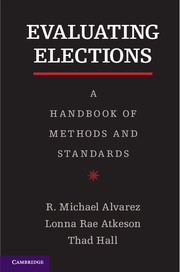Book contents
- Frontmatter
- Contents
- Acknowledgments
- Introduction
- 1 The Electoral Ecosystem
- 2 Easily Available Data for Performance Evaluation
- 3 Measuring the Experiences of Voters
- 4 Measuring the Performance of Poll Workers
- 5 Auditing the Election Ecosystem
- 6 Election Observation
- Conclusion
- Appendix: Precinct Opening, Closing, Election Day Forms
- References
- Index
2 - Easily Available Data for Performance Evaluation
Published online by Cambridge University Press: 05 December 2012
- Frontmatter
- Contents
- Acknowledgments
- Introduction
- 1 The Electoral Ecosystem
- 2 Easily Available Data for Performance Evaluation
- 3 Measuring the Experiences of Voters
- 4 Measuring the Performance of Poll Workers
- 5 Auditing the Election Ecosystem
- 6 Election Observation
- Conclusion
- Appendix: Precinct Opening, Closing, Election Day Forms
- References
- Index
Summary
The first question that arose in the immediate aftermath of the 2000 presidential election, when we started to study the performance of election processes in the United States, was a simple one: what data were readily available that could be used to assess the problems seen in the election, especially in Florida? That question led those of us who were involved in the early stages of the Caltech/MIT Voting Technology Project (VTP) to focus on the measure called the residual vote – a measure that we now see as a vital and readily available gauge of the accuracy and reliability of voting technologies.
However, as we discussed in the first two chapters of this book, there are other readily available sources of election performance data that election officials routinely collect but typically do not employ in a broader and more comprehensive performance-based management and evaluation process. These data form the basis for developing a set of indicators that can be used to assess the performance of elections in a given jurisdiction and the backbone for a performance-based management system that can be used to engage in ongoing quality improvements of the electoral process.
- Type
- Chapter
- Information
- Evaluating ElectionsA Handbook of Methods and Standards, pp. 39 - 59Publisher: Cambridge University PressPrint publication year: 2012

